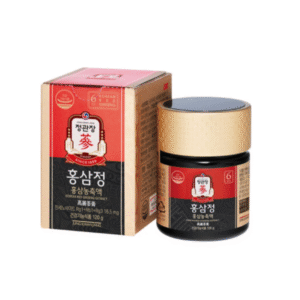A Natural Ally for Blood Sugar Balance
In today’s world, millions struggle with insulin resistance — a silent condition that precedes type 2 diabetes and metabolic disorders. When your body’s cells stop responding properly to insulin, glucose builds up in the bloodstream, leading to fatigue, weight gain, and long-term organ stress.
Fortunately, nature offers potent allies for restoring balance. Among them, Korean Red Ginseng (Panax ginseng Meyer) stands out as a scientifically supported adaptogenic herb known to enhance insulin sensitivity, improve glucose metabolism, and support overall metabolic health.
1. What Is Insulin Sensitivity—and Why It Matters
Insulin is the key hormone that allows glucose to enter your cells for energy. High insulin sensitivity means your body effectively uses this hormone; low sensitivity (insulin resistance) means your cells need more insulin to get the same job done.
Over time, this imbalance can lead to:
- Elevated blood sugar
- Fat storage (especially in the abdomen)
- Fatigue and inflammation
- Increased risk of cardiovascular disease and type 2 diabetes
The goal of modern metabolic health strategies is therefore to restore insulin sensitivity naturally—and this is where Korean Red Ginseng plays a significant role.
2. Korean Red Ginseng: A Metabolic Modulator
Unlike ordinary ginseng, Korean Red Ginseng (KRG) is steamed and dried, a process that transforms its natural compounds into powerful ginsenosides (such as Rg1, Rb1, and Rg3).
These bioactive molecules have been shown to:
- Improve glucose uptake in muscle and fat cells
- Enhance insulin receptor signaling
- Reduce oxidative stress and inflammation—two key drivers of insulin resistance
A 2020 review in the Journal of Ginseng Research concluded that KRG supplementation significantly improved fasting glucose and insulin sensitivity markers in both diabetic and pre-diabetic patients. [Source]
3. How Korean Red Ginseng Improves Insulin Sensitivity
a. Enhancing Cellular Glucose Uptake
Ginsenosides stimulate a key metabolic pathway called AMP-activated protein kinase (AMPK) — the body’s “energy sensor.”
When AMPK is activated, it:
- Increases glucose transport into cells
- Encourages fat burning (lipolysis)
- Reduces glucose production in the liver
This mechanism helps normalize blood sugar naturally, similar to how exercise enhances insulin sensitivity.
b. Protecting Pancreatic Beta Cells
Chronic inflammation and oxidative stress damage the pancreas, impairing insulin production. KRG’s antioxidant properties protect beta cells and preserve insulin secretion capacity.
A clinical study published in Phytotherapy Research (2018) showed that 12 weeks of Korean Red Ginseng supplementation improved beta-cell function and reduced oxidative markers in subjects with metabolic syndrome.
c. Reducing Inflammation and Cortisol
High stress hormones such as cortisol worsen insulin resistance. Korean Red Ginseng, being a potent adaptogen, regulates the hypothalamic–pituitary–adrenal (HPA) axis to lower stress-related metabolic disruption. The result: better hormonal balance and improved insulin response.
4. Clinical Studies Supporting Ginseng’s Role in Glucose Control
- Randomized controlled trial (Seoul National University, 2019): Participants who took 2 g/day of Korean Red Ginseng extract showed significant decreases in fasting glucose and HOMA-IR (insulin resistance index) compared to placebo.
- Meta-analysis (Frontiers in Endocrinology, 2021): Across 12 clinical studies, Panax ginseng supplementation improved glycemic control, HbA1c levels, and insulin sensitivity without causing hypoglycemia.
- Animal research (Diabetes & Metabolism Journal, 2020): Ginsenoside Rb1 improved insulin receptor activity and reduced inflammation in the liver and skeletal muscle tissues of insulin-resistant mice.
5. Beyond Blood Sugar: Full-Spectrum Metabolic Benefits
Regular consumption of Korean Red Ginseng doesn’t just support glucose balance — it promotes overall metabolic harmony. Benefits include:
- Enhanced energy production through better glucose utilization
- Reduced abdominal fat accumulation
- Improved lipid profile (lower triglycerides and LDL cholesterol)
- Decreased markers of systemic inflammation
By restoring the body’s natural ability to process energy efficiently, Korean Red Ginseng serves as a cornerstone for metabolic resilience and long-term vitality.
6. How to Take Korean Red Ginseng for Metabolic Support
- Dosage: 1–2 grams of standardized extract daily (containing 3–5% ginsenosides)
- Best time: Morning, before breakfast or exercise
- Forms: Capsules, tonics, teas, or concentrated extracts
- Duration: Noticeable improvements often appear after 4–8 weeks of consistent use
Always choose authentic Korean-grown red ginseng, as its ginsenoside content and quality control are superior to other varieties.
7. Safety and Considerations
Korean Red Ginseng is generally safe for long-term use. However:
- People with diabetes should monitor glucose closely when combining it with medication.
- Pregnant or breastfeeding women should consult healthcare professionals before use.
- Avoid counterfeit or non-standardized products lacking quality certification.
Conclusion: Nature’s Support for Modern Metabolic Balance
Korean Red Ginseng is more than an energy tonic—it is a metabolic regulator that helps your body respond to insulin more effectively, supports healthy blood sugar, and reduces inflammation.
By integrating it into a balanced lifestyle — including exercise, whole foods, and stress management — you can restore natural metabolic harmony and long-term wellness.
🇰🇷 Premium Korean Ginseng Online Shop







